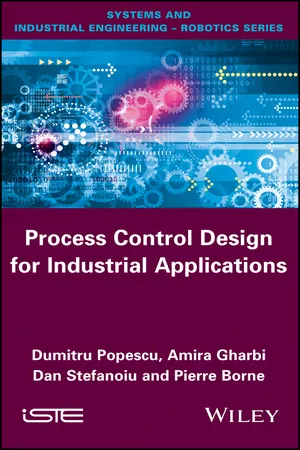
Process Control Design for Industrial Applications
- English
- ePUB (mobile friendly)
- Available on iOS & Android
Process Control Design for Industrial Applications
About this book
This book presents the most important methods used for the design of digital controls implemented in industrial applications. The best modelling and identification techniques for dynamical systems are presented as well as the algorithms for the implementation of the modern solutions of process control. The proposed described methods are illustrated by various case studies for the main industrial sectors
There exist a number of books related each one to a single type of control, yet usually without comparisons for various industrial sectors. Some other books present modelling and identification methods or signal processing. This book presents the methodsto solve all the problems linked to the design of a process control without the need to find additional information.
Frequently asked questions
- Essential is ideal for learners and professionals who enjoy exploring a wide range of subjects. Access the Essential Library with 800,000+ trusted titles and best-sellers across business, personal growth, and the humanities. Includes unlimited reading time and Standard Read Aloud voice.
- Complete: Perfect for advanced learners and researchers needing full, unrestricted access. Unlock 1.4M+ books across hundreds of subjects, including academic and specialized titles. The Complete Plan also includes advanced features like Premium Read Aloud and Research Assistant.
Please note we cannot support devices running on iOS 13 and Android 7 or earlier. Learn more about using the app.
Information
1
Introduction – Models and Dynamic Systems
1.1. Overview
Table of contents
- Cover
- Table of Contents
- Title
- Copyright
- Preface
- List of Acronyms and Notations
- 1 Introduction – Models and Dynamic Systems
- 2 Linear Identification of Closed-Loop Systems
- 3 Digital Control Design Using Pole Placement
- 4 Adaptive Control and Robust Control
- 5 Multimodel Control
- 6 Ill-Defined and/or Uncertain Systems
- 7 Modeling and Control of an Elementary Industrial Process
- 8 Industrial Applications – Case Studies
- Appendix A: Matrix Transformation from Any Representation to the Companion Form or Arrow Form
- Appendix B: Determination of the Maximum Error for Pole Placement for a Nonlinear Third-Order Process
- Appendix C: Determining the Attractor in a Nonlinear Process Controlled by Linear Decoupling
- Appendix D: Overvaluation of the Maximum Error in a Tracking Problem for a Lur’e Postnikov Type Process
- Blibliography
- Index
- End User License Agreement